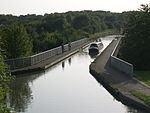Haversham

Haversham is a village and former civil parish, now in the parish of Haversham-cum-Little Linford, in the City of Milton Keynes unitary authority area, in Buckinghamshire, England. It is situated to the north of (and separated by the River Great Ouse from) the Milton Keynes urban area, near Wolverton and about 5 miles (8 km) north of Central Milton Keynes. The village name is an Old English word that means 'Haefer's homestead'. In the Domesday Book of 1086, when it belonged to the Peverell family, it was listed as Havresham. The ancient manor house in the village, which was fortified in 1304, was largely burnt down, but parts of it still remain in a farm house just outside the main village. Haversham was once a village of farm-workers' dwellings. As of 2012, only Hill Farm, Grange Farm and Crossroads Farm remain as active working farms. The village has two distinct settlements separated by farmland. The older part of the village contains the manor house. It lies at elevations between 60 metres and 65 metres above mean sea level, just above the flood plain of the Ouse. In the 1930s, 'New Haversham' was built nearer Wolverton, to house staff working at the Wolverton railway works nearby. New Haversham contains the primary school and is on ground at elevations between 65 metres and 75 metres, overlooking the Ouse Valley. In the 1970s, ARC dug the river meadows near the site of the old village of Stanton Low for gravel extraction, leaving behind the large man made lakes that surround Haversham to the south today. These lakes are the home to the Hanson Centre and to the Haversham Sailing Club, one of the sailing clubs around Milton Keynes. Just south of Haversham beside the road to Wolverton, is the Wolverton Railway Viaduct over the valley of the river Great Ouse, of a Stephenson's design, carrying the West Coast Main Line. The village gave its name to HMS Haversham, a Ham class minesweeper.
Excerpt from the Wikipedia article Haversham (License: CC BY-SA 3.0, Authors, Images).Haversham
High Street,
Geographical coordinates (GPS) Address Nearby Places Show on map
Geographical coordinates (GPS)
| Latitude | Longitude |
|---|---|
| N 52.079 ° | E -0.79 ° |
Address
High Street
MK19 7DZ , Haversham-cum-Little Linford
England, United Kingdom
Open on Google Maps









